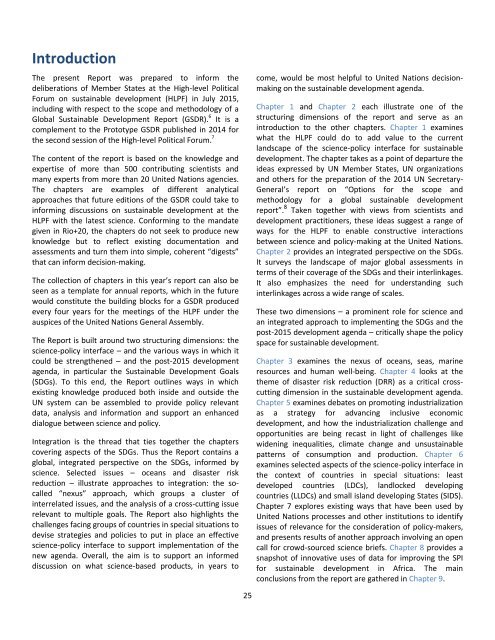1HlG51J
1HlG51J
1HlG51J
Create successful ePaper yourself
Turn your PDF publications into a flip-book with our unique Google optimized e-Paper software.
IntroductionThe present Report was prepared to inform thedeliberations of Member States at the High-level PoliticalForum on sustainable development (HLPF) in July 2015,including with respect to the scope and methodology of aGlobal Sustainable Development Report (GSDR). 6 It is acomplement to the Prototype GSDR published in 2014 forthe second session of the High-level Political Forum. 7The content of the report is based on the knowledge andexpertise of more than 500 contributing scientists andmany experts from more than 20 United Nations agencies.The chapters are examples of different analyticalapproaches that future editions of the GSDR could take toinforming discussions on sustainable development at theHLPF with the latest science. Conforming to the mandategiven in Rio+20, the chapters do not seek to produce newknowledge but to reflect existing documentation andassessments and turn them into simple, coherent “digests”that can inform decision-making.The collection of chapters in this year’s report can also beseen as a template for annual reports, which in the futurewould constitute the building blocks for a GSDR producedevery four years for the meetings of the HLPF under theauspices of the United Nations General Assembly.The Report is built around two structuring dimensions: thescience-policy interface – and the various ways in which itcould be strengthened – and the post-2015 developmentagenda, in particular the Sustainable Development Goals(SDGs). To this end, the Report outlines ways in whichexisting knowledge produced both inside and outside theUN system can be assembled to provide policy relevantdata, analysis and information and support an enhanceddialogue between science and policy.Integration is the thread that ties together the chapterscovering aspects of the SDGs. Thus the Report contains aglobal, integrated perspective on the SDGs, informed byscience. Selected issues – oceans and disaster riskreduction – illustrate approaches to integration: the socalled“nexus” approach, which groups a cluster ofinterrelated issues, and the analysis of a cross-cutting issuerelevant to multiple goals. The Report also highlights thechallenges facing groups of countries in special situations todevise strategies and policies to put in place an effectivescience-policy interface to support implementation of thenew agenda. Overall, the aim is to support an informeddiscussion on what science-based products, in years tocome, would be most helpful to United Nations decisionmakingon the sustainable development agenda.Chapter 1 and Chapter 2 each illustrate one of thestructuring dimensions of the report and serve as anintroduction to the other chapters. Chapter 1 examineswhat the HLPF could do to add value to the currentlandscape of the science-policy interface for sustainabledevelopment. The chapter takes as a point of departure theideas expressed by UN Member States, UN organizationsand others for the preparation of the 2014 UN Secretary-General’s report on “Options for the scope andmethodology for a global sustainable developmentreport”. 8 Taken together with views from scientists anddevelopment practitioners, these ideas suggest a range ofways for the HLPF to enable constructive interactionsbetween science and policy-making at the United Nations.Chapter 2 provides an integrated perspective on the SDGs.It surveys the landscape of major global assessments interms of their coverage of the SDGs and their interlinkages.It also emphasizes the need for understanding suchinterlinkages across a wide range of scales.These two dimensions – a prominent role for science andan integrated approach to implementing the SDGs and thepost-2015 development agenda – critically shape the policyspace for sustainable development.Chapter 3 examines the nexus of oceans, seas, marineresources and human well-being. Chapter 4 looks at thetheme of disaster risk reduction (DRR) as a critical crosscuttingdimension in the sustainable development agenda.Chapter 5 examines debates on promoting industrializationas a strategy for advancing inclusive economicdevelopment, and how the industrialization challenge andopportunities are being recast in light of challenges likewidening inequalities, climate change and unsustainablepatterns of consumption and production. Chapter 6examines selected aspects of the science-policy interface inthe context of countries in special situations: leastdeveloped countries (LDCs), landlocked developingcountries (LLDCs) and small island developing States (SIDS).Chapter 7 explores existing ways that have been used byUnited Nations processes and other institutions to identifyissues of relevance for the consideration of policy-makers,and presents results of another approach involving an opencall for crowd-sourced science briefs. Chapter 8 provides asnapshot of innovative uses of data for improving the SPIfor sustainable development in Africa. The mainconclusions from the report are gathered in Chapter 9.25




